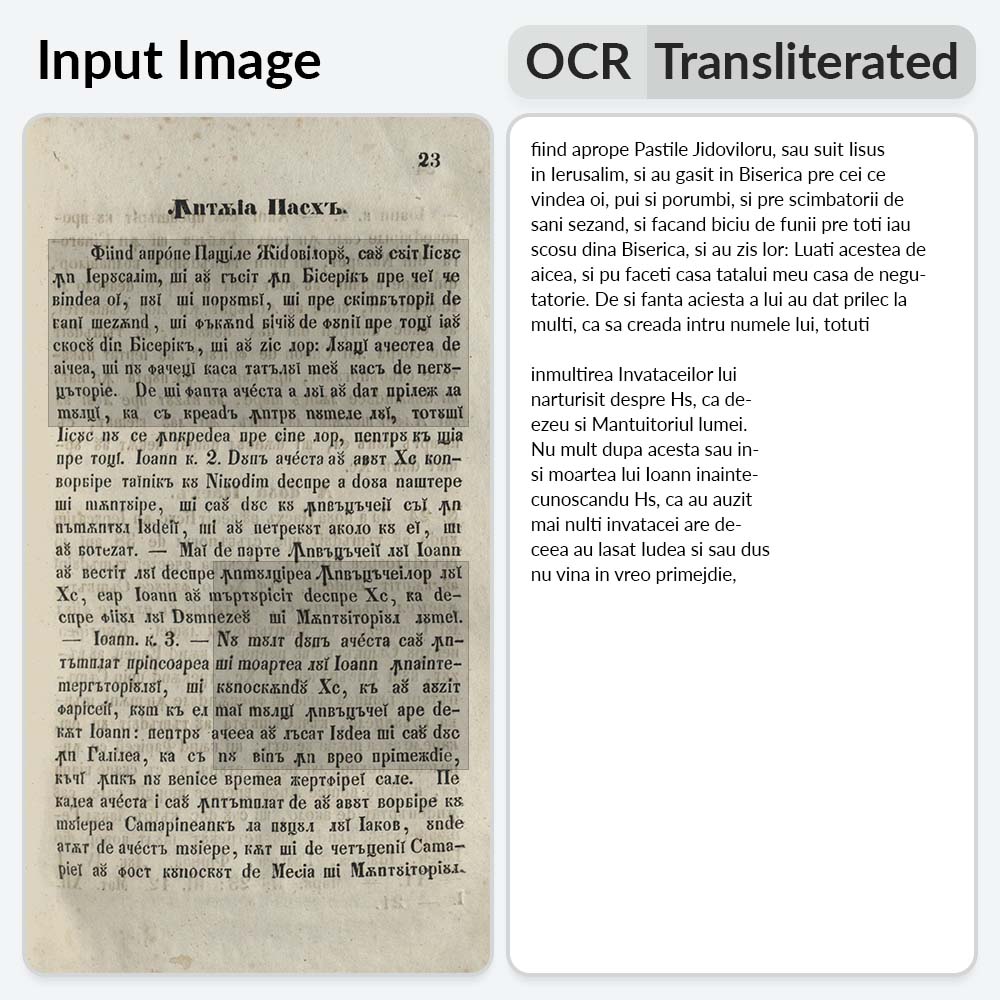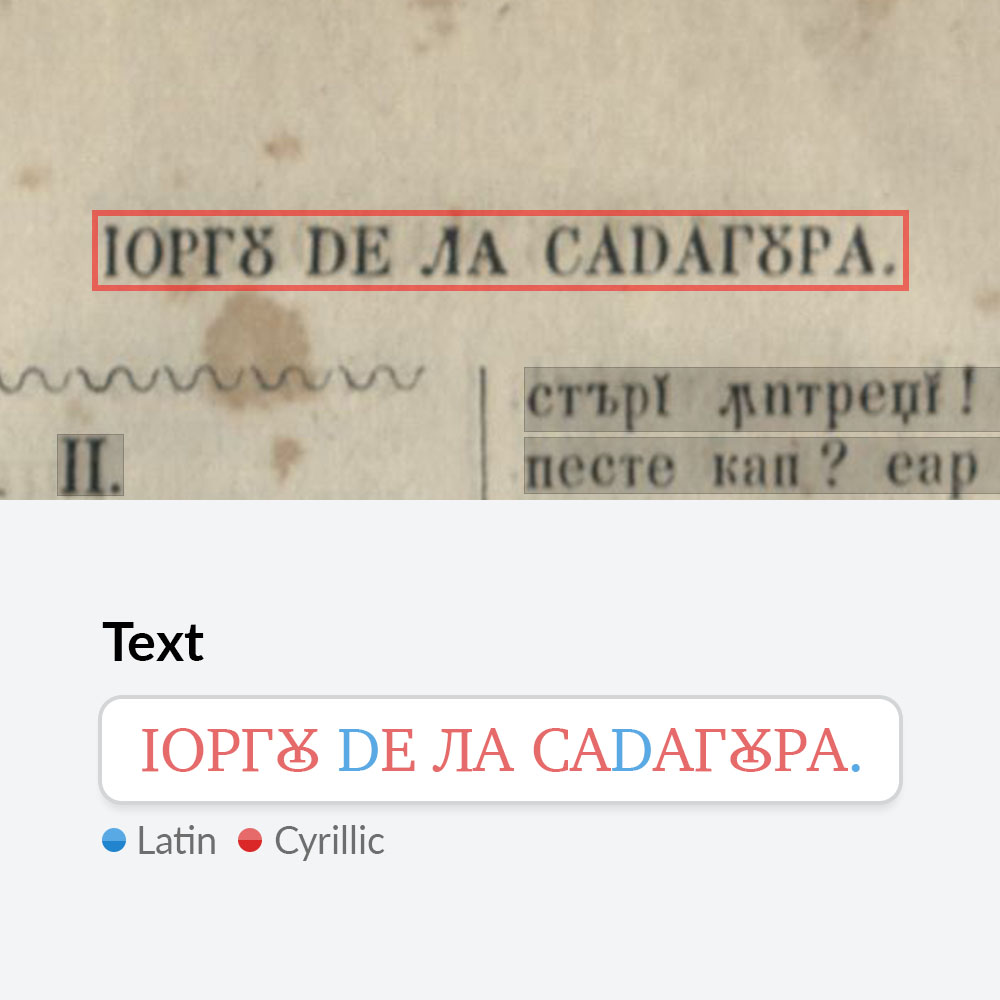Research Interests
As a computer science professor and researcher, my passion lies in artificial intelligence and its related fields, including machine learning, neural networks, and image processing. My work in these areas has resulted in several publications and my Ph.D. thesis, which you can explore below.
Currently, I am working on an exciting project called ROTLA, which uses Tesseract OCR technology to transliterate old Romanian documents. This project aims to develop a highly accurate OCR model to automate the transliteration of national heritage documents.
Learn more about ROTLAPhD Thesis
In March 2022, I successfully defended my Ph.D. thesis, which focused on designing a nature-inspired simulator to model wind patterns and forecast cloud movements.
This was a challenging yet rewarding experience that expanded my expertise in computer science. I am proud of this achievement and look forward to continuing my contributions to the field through research and teaching.
Department of Computer Science
Cloud Movement Forecasting based on Wind Modeled from Satellite Imagery and a Modified Flocking Algorithm
- Marius E. Penteliuc
- Faculty of Mathematics and Computer Science
- Department of Computer Science
- West University of Timișoara, Romania
- marius.penteliuc@e-uvt.ro
Abstract — Photovoltaic (PV) panels are increasingly used for generating power by transforming Sun irradiance into electric output. Transient clouds are absorbing irradiance and passing over a solar farm greatly affects its power production capability. PVs operate at their maximum capacity only when exposed to clear skies. Because of this PV output is variable and PV plants are hard to integrate into the power grid. Identification and forecasting of cloud movement are crucial for operators to take appropriate actions to meet energy demand such as starting backup generators and compensating with power reserves. Many methods rely on ground cameras and sensors, or satellite imagery, but they lack granularity, generalization, and assume idealistic linear motion of clouds over long distances. In the thesis, I propose and describe a solution to forecasting short-term cloud movement using only data obtained from satellite imagery without the need for gathering auxiliary information from other sources. It is based on a nature-inspired flocking behavior simulator and produces granular forecasts of cloud positions for the entire scene. It also generates a wind map that covers the scene and is continuously updated with each forecast. The algorithm is tested for scalability on multi-core CPUs and GPU cards, and performance is compared to a feed-forward back propagation neural network trained to forecast cloud movement from satellite imagery. The proposed solution provides short-term wind and cloud forecasts of up to several hours while being lightweight and using fewer resources than a compared neural network. The scalability of the implementation is tested and the speed-up values are up to 1000 times. Future development into a web service and the possibility to utilize images from all-sky cameras is discussed.
Tools
One of my passions as a computer science researcher is developing custom tools to aid my work and that of my colleagues. Below are some open-source tools I've created, available on GitHub. I invite you to explore and contribute to these projects.
Transliteration Playground
This tool, developed for the ROTLA project, allows you to test our OCR model's transliteration abilities. Upload an image, mark regions, recognize text, and copy the transliterated output.
Try the web app View the sourceBox Editor for Tesseract
This free web app lets you edit Tesseract OCR LSTM box files in WordStr format, featuring automatic text line detection and tools for managing bounding boxes.
Try the web app View the sourcePublished Papers
Throughout my career, I have published several papers in esteemed academic journals and conferences, covering topics such as artificial intelligence, machine learning, and image processing.
I invite you to explore the abstracts of my papers, which represent significant contributions to the field of computer science. Whether you are a fellow researcher, student, or simply interested in the latest developments, I hope you find these papers insightful and engaging.
Comparing ML OCR Engines on Texts from 19th Century Written in the Romanian Transitional Script
- Marc Frîncu†, Marius E. Penteliuc, Simina Frîncu, Gheorhe Bran, and Manuela Zanescu‡
- Department of Computer Science
- West University of Timișoara, Romania
- {marius.penteliuc, ioana.frincu, gheorghe.bran, manuela.zanescu}@e-uvt.ro
- †School of Science and Technology
- Nottingham Trent University, United Kingdom
- marc.frincu@ntu.ac.uk
- ‡Central University Library Timișoara, Romania
Abstract — Many 19th century Romanian texts are written in the Transitional Script (RTS) combining Cyrillic and Latin characters in variable proportions depending on specific factors (period, region, publishing house, literary trends, and personal beliefs). Thousands of heritage documents in numerous libraries across Romania have yet to be digitized. Reading texts written in RTS is challenging for modern scholars, today’s students and OCR engines which due to specific particularities have difficulties in processing them. Transfer learning can be used to train state-of-the-art tools such as Tesseract or Transkribus, but their efficiency varies according to the underlying deep neural network, the training parameters, and the particularities of the scanned images and used scripts. In this paper, we compare the performance of two architectures on 180 OCR models for 5 scenarios (best CER <4.6% for Tesseract) and discuss OCR challenges on RTS texts.
Keywords — training; optical character recognition; transfer learning; training data; phonetics; data models.
Challenges and Solutions in Transliterating 19th Century Romanian Texts from the Transitional to the Latin Script
- Marc Frîncu†, Simina Frîncu‡, and Marius E. Penteliuc‡
- †School of Science and Technology
- Nottingham Trent University, United Kingdom
- marc.frincu@ntu.ac.uk
- ‡Faculty of Mathematics and Computer Science
- Department of Computer Science
- West University of Timișoara, Romania
- {ioana.frincu, marius.penteliuc}@e-uvt.ro
Abstract — During the 19th century, the Romanian script has undergone a massive yet uneven transition from the Cyrillic to the current Latin alphabet. The amount of existing literature written in that script as well as the problems it poses for OCR and transliteration engines make the problem highly challenging from a Big Data perspective. In this paper, we discuss the issues and propose and test a machine-learning solution trained on small datasets using either transfer learning from Latin/Cyrillic or from scratch.
A Solar Radiation Forecast Platform Spanning over the Edge-Cloud Continuum
- Marc Frîncu†, Marius E. Penteliuc‡, and Adrian Spătaru‡
- †School of Science and Technology
- Nottingham Trent University, United Kingdom
- marc.frincu@ntu.ac.uk
- ‡Faculty of Mathematics and Computer Science
- Department of Computer Science
- West University of Timișoara, Romania
- {marius.penteliuc, adrian.spataru}@e-uvt.ro
Abstract — The prediction of PV output represents an important task for PV farm operators as it enables them to forecast the energy they will produce and sell on the energy market. Existing approaches rely on a combination of satellite/all-sky images and numerical methods which for high spatial resolutions require considerable processing time and resources. In this paper, we propose a hybrid egde–cloud platform that leverages the performance of edge devices to perform time-critical computations locally, while delegating the rest to the remote cloud infrastructure. The proposed platform relies on novel metaheuristics algorithms for cloud dynamics detection and proposes to forecast irradiance by analyzing pixel values taken with various filters/bands. The results demonstrate the scalability improvement when using GPU-enabled devices and the potential of using pixel information instead of cloud types to infer irradiance.
Keywords — solar irradiance; cloud dynamics; cloud type; metaheuristics; cloud–edge platform; smart grid.
Processing Large Satellite Imagery to Estimate Solar Irradiance
- Marius E. Penteliuc
- Faculty of Mathematics and Computer Science
- Department of Computer Science
- West University of Timișoara, Romania
- marius.penteliuc@e-uvt.ro
Abstract — We use satellite imagery to identify cloud types and correlate with irradiance data from a solar platform. Processing the large images takes several minutes. Integrating into a web service would enable multiple users to estimate solar irradiance using just satellite imagery. It would also allow for the processing of many images at once as more remote sensing satellites are launched and data is easily accessible. The Sentinel 2 Cirrus Band shows an 81% correlation with the diffuse solar irradiance values measured at the platform.
Keywords — satellite imagery; irradiance; cloud types.
Short Term Cloud Motion Forecast based on Boid's Algorithm for use in PV Output Prediction
- Marius E. Penteliuc* and Marc Frîncu†
- *Faculty of Mathematics and Computer Science
- Department of Computer Science
- West University of Timișoara, Romania
- marius.penteliuc@e-uvt.ro
- †School of Science and Technology
- Nottingham Trent University, United Kingdom
- marc.frincu@ntu.ac.uk
Abstract — Forecasting cloud motion and dynamics is crucial for many areas of study. Solar energy production depends on the cloud coverage over the area which impacts PV output, by clouds limiting the incoming solar irradiance. In this paper we propose an adaptation of a nature-inspired technique called the Flocking Behavior Algorithm (or Boids Algorithm) for the problem of cloud motion forecasting, for nowcasting and intra-day prediction windows. Without limiting the application of the algorithm we validate it on a sequence of satellite images and show its efficiency for short term forecasting.
Keywords — cloud motion forecast; nature inspired algorithm; Boids Algorithm.
Parallel Cloud Movement Forecasting based on a Modified Boids Flocking Algorithm
- Adrian Spătaru*, Larisa Tranca*, Marius E. Penteliuc*, and Marc Frîncu†
- *Faculty of Mathematics and Computer Science
- Department of Computer Science
- West University of Timișoara, Romania
- {adrian.spataru, larisa.tranca96, marius.penteliuc}@e-uvt.ro
- †School of Science and Technology
- Nottingham Trent University, United Kingdom
- marc.frincu@ntu.ac.uk
Abstract — Nowcasting is vital for PV farms in order to match supply and demand on energy markets. The accuracy of existing forecasting methods relies on short term modelling of cloud movement and dynamics by combining satellite images with ground based allsky observations. Cloud movement is modelled based on complex nonlinear numerical models which on the short term are outperformed by image analysis techniques. In this research we propose a simplified nature inspired model for nowcasting which scales with the data. The model is based on forecasting wind direction extracted from motion vector fields by modelling wind using a modified Boids Flocking algorithm. We show that the model is accurate in predicting the cloud coverage up to several hours ahead and that it scales with the number of particles on shared memory systems suited for commodity machines available to PV farm operators.
Keywords — Boids flocking algorithm; Cloud movement; OpenMP; CUDA.
Prediction of Cloud Movement from Satellite Images using Neural Networks
- Marius E. Penteliuc and Marc Frîncu
- West University of Timișoara
- Faculty of Mathematics and Computer Science
- Department of Computer Science
- Timișoara, Romania
- {marius.penteliuc, marc.frincu}@e-uvt.ro
Abstract — Predicting cloud movement and dynamics is an important aspect in several areas, including prediction of solar energy generation. Knowing where a cloud will be or how it evolves over a given geographical area can help energy providers to better estimate their production levels. In this paper we propose a novel approach to predicting cloud movement based on satellite imagery. It combines techniques of generating motion vectors from sequential images with neural networks. First, the images are masked to isolate cloud pixels, then Farneback’s version of the Optical Flow algorithm is used to detect motion from one image to the next and generate motion vector flow for each pair of images. After that, a feed forward back propagation neural network is trained with the vector data derived from the dataset imagery. Different parameters for the duration of the training, size of the input, and the neighborhood radius of one point in the scene are used. Promising results are presented and discussed to weight the potential of the proposed algorithm for forecasting cloud cover and cloud position in a scene.
Keywords — cloud motion; forecasting; neural networks; satellite imagery.

